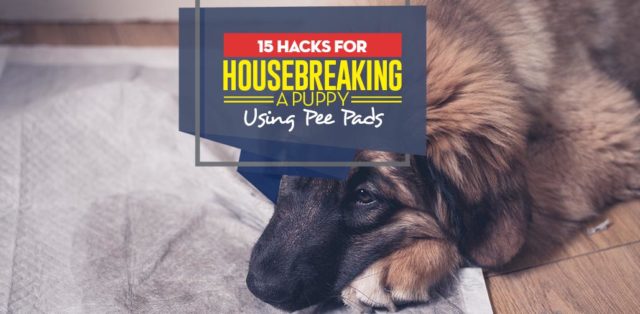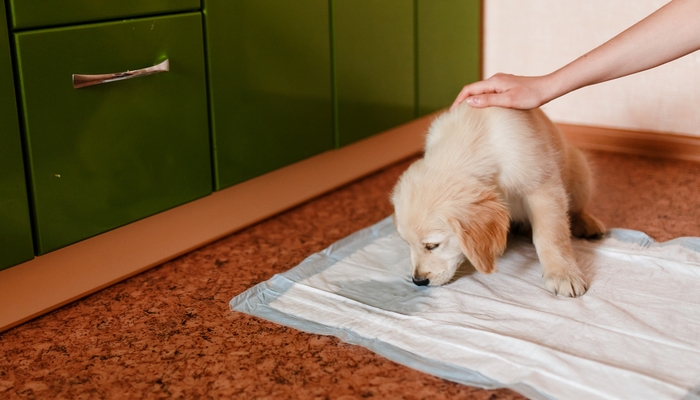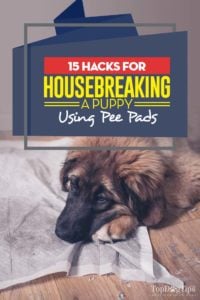
Table of Contents
- 15 Tips on How to Housebreak a Puppy at Home (Using Puppy Pee Pads)
- 1. Take Your Puppy Out Often
- 2. Keep Looking for the Signs
- 3. Place the Pee Pad in the Same Spot, Every Time
- 4. Crate Train the Puppy
- 5. Reward Them for Good Behavior
- 6. Never Punish the Puppy for Bathroom Accidents
- 7. Contain Them While You're Away
- 8. Start with Multiple Dog Pee Pads
- 9. Get Them Used to a Schedule
- 10. Remember Nap Time
- 11. Leash May Be Helpful
- 12. Work Gradually
- 13. Move Toward the Door
- 14. Use a Verbal Cue
- 15. Praise Them Immediately
All current or future puppy owners are aware of the need for housebreaking, but sometimes things just don't go according to plan.
Here's what you should know about how to housebreak a puppy at home, plus 15 tips to make the process easier and quicker.
What's a Puppy Pee Pad?
As we've talked about in our recent podcast, puppy pee pads are the best tool for housebreaking training.
These are square pads that sit on the floor and soak up your puppy's toilet mess.
Activated Carbon Training Pads are some of the best on the market. They are very easy to use and dispose of once soiled.
These products contain adhesive points for sticking to the floor, and they come in various sizes to suit all dogs.
Sandwiched between the leak-proof layers is a thick pad core.
Some are better than the others, which is why we did the research, tested them, and ranked the best dog pee pads based on our editors' tests, some of which you can see here.
Once the dog pees on the pad, the core turns to gel.
Puppy potty pads also have a quick-dry surface on the top, so your puppy won't step in the urine and track it around the house.
Some dog potty pads, like the Bark Potty, even come with non-toxic synthetic grass on the surface to entice your puppy to go to the bathroom.

15 Tips on How to Housebreak a Puppy at Home (Using Puppy Pee Pads)
 Housebreaking a puppy takes patience and consistency, and the process is likely to take weeks, not days.
Housebreaking a puppy takes patience and consistency, and the process is likely to take weeks, not days.
These tips will help you stay on track with your potty training efforts.
1. Take Your Puppy Out Often
A puppy has a small bladder, so it will need to pee often.
To train a puppy to pee outside, you will need to take them out every few hours, and sometimes even every hour.
For some people, that can be impossible. Even for those able to do this, it's an obvious inconvenience.
That's when puppy pee pads need to be used.
Simply place puppy pads in your home somewhere, always in the same location.
Instead of taking your dog to the same potty spot outside, bring them to the potty pad when it's time for a bathroom break.
2. Keep Looking for the Signs
Signs to watch out for are when your dog begins sniffing the ground frantically, searching for somewhere suitable to pee.
If you're further along in your puppy potty training endeavor, they may also look for a place to hide.
As they already know peeing in the house is not an acceptable behavior but they aren't good at holding their pee yet.
3. Place the Pee Pad in the Same Spot, Every Time
When learning how to housebreak a puppy at home using these pee pads, it's crucial to place them in the exact same spot, every single time.
Moving it around will only confuse the dog and set you back in your housebreaking efforts.
By keeping the pads in the same spot, the puppy will learn exactly where to go for toileting.
4. Crate Train the Puppy
Consider restricting the area that the puppy can run around in until you have completed toilet training.
The best way to do this is to simultaneously crate train a puppy while you're also housebreaking them.
Place the potty pad inside the dog crate (or a playpen if you choose to use that instead of crates).
If the puppy has free access everywhere but still has accidents around the home.
They are more likely to go sniff out those places a second time around.
5. Reward Them for Good Behavior
When learning how to housebreak a puppy at home an essential part of effective puppy housebreaking is using positive reinforcement.
So always keep a supply of treats to reward the puppy's good behavior.
Your dog will soon learn that if they use the potty pee pad instead of a random spot, they get a tasty treat.
6. Never Punish the Puppy for Bathroom Accidents
Along with rewarding good behavior, you should also not punish them if they have an accident.
This is going to happen often as you start figuring out how to housebreak a puppy at home, so accept it.
When you see it happen, gently lift the puppy onto the pad and use a cue word/command.
Exposing your anger to the puppy will only make things worse and enforce them to sneak away to do their toileting out of sight.
7. Contain Them While You're Away
If you're also crate training a puppy, then whenever you go outside, it's highly recommended that you contain them in a crate.
If you don't use a crate, you can instead choose a playpen to contain the puppy, which gives them more space and freedom.
Don’t forget to put down some pee pads inside the crate or playpen.
A puppy's natural instinct is to eat, sleep and use the bathroom in completely separate areas.
By confining the dog into a limited area, you're increasing the likelihood that they won't use the bathroom while you're gone and will learn to keep it in.
8. Start with Multiple Dog Pee Pads
When learning how to housebreak a puppy at home begin with more than one dog pee pad.
At first, you can leave them in various places around the house where the puppy is allowed.
Gradually, begin reducing the number of training pads available until only one remain.
You may find yourself putting them back whenever accidents occur.
Particularly if the accident is where a removed puppy pad was situated in the first place.
Maybe that's their favorite area to pee, so you may need to reconsider where the permanent pad location should be.
9. Get Them Used to a Schedule
Maintaining a routine is crucial to all dogs, no matter their age.
As the puppy grows, the number of times they need to pee or poo will decrease and will mostly happen after feed time.
If the dog eats twice a day, morning and evening, that is when you should be more attentive to placing them on the pad.
10. Remember Nap Time
Dogs sleep a lot.
When your puppy has just woken up from a nap, immediately bring them to their pee pad.
If the dog does nothing, try it again in about 5 minutes.
This is because, after a long sleep, it's very likely that the puppy's small bladder will need a release.
11. Leash May Be Helpful
If a puppy wanders from the pad every time you put them there, then get into the habit of keeping them on a leash.
Stand there until you feel they've been on the potty pad long enough.
Clearly, if the dog does nothing after 5-10 minutes, let them go.
12. Work Gradually
When learning how to housebreak a puppy at home, it's important that you remember to increase their freedom gradually.
Once puppy stops having accidents, allow them more freedom.
It could be that the pup has learned to hold its bladder for longer.
Maybe they're also getting an inkling where to go for toileting. Should those accidents return, go back to a stage.
13. Move Toward the Door
The goal for most is to have the dog toilet outside of the house.
To achieve this, start moving the pee pad closer and closer towards the outside door.
Don’t rush it or the puppy may not realize their toilet space has moved. With patience, you will soon be by the door.
The next step would be to move it outside.
14. Use a Verbal Cue
When learning how to housebreak a puppy at home it may help if you have a regular cue word/command to use when you place the puppy on the pad, such as “pee-pee time.”
Also, have another word for praise.
It’s not so much the words we use, but the tone of voice we use when we say them.
 Dogs are quick to learn associations with your tone of voice.
Dogs are quick to learn associations with your tone of voice.
When you say “clever boy,” the chances are you are using a different tone to when you say, “wee-wee time.”
They will know which tone belongs to which task, and which phrase brings about a reward.
15. Praise Them Immediately
Dogs are quick to forget what they have just done.
If you praise straight away, your puppy will associate why you are rewarding them.
Once the dog understands this, they will seek out that praise and continue to perform the task that brings such a tasty and happy reward.
READ NEXT: How Much to Feed a Puppy & How Often Should Puppies Eat
Disclosure: We may earn affiliate commissions at no cost to you from the links on this page. This did not affect our assessment of products. Read more here and find full disclosure here.













